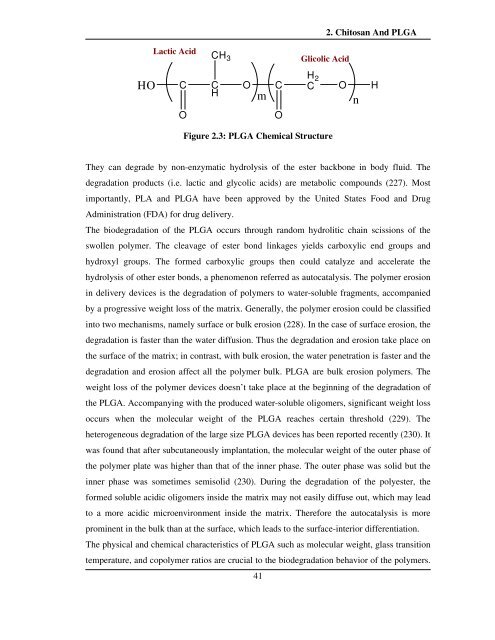chitosan and plga microspheres as drug delivery ... - UniCA Eprints
chitosan and plga microspheres as drug delivery ... - UniCA Eprints
chitosan and plga microspheres as drug delivery ... - UniCA Eprints
Create successful ePaper yourself
Turn your PDF publications into a flip-book with our unique Google optimized e-Paper software.
2. Chitosan And PLGALactic AcidGlicolic AcidHOCOCHCH 3O CmOH 2C O HnFigure 2.3: PLGA Chemical StructureThey can degrade by non-enzymatic hydrolysis of the ester backbone in body fluid. Thedegradation products (i.e. lactic <strong>and</strong> glycolic acids) are metabolic compounds (227). Mostimportantly, PLA <strong>and</strong> PLGA have been approved by the United States Food <strong>and</strong> DrugAdministration (FDA) for <strong>drug</strong> <strong>delivery</strong>.The biodegradation of the PLGA occurs through r<strong>and</strong>om hydrolitic chain scissions of theswollen polymer. The cleavage of ester bond linkages yields carboxylic end groups <strong>and</strong>hydroxyl groups. The formed carboxylic groups then could catalyze <strong>and</strong> accelerate thehydrolysis of other ester bonds, a phenomenon referred <strong>as</strong> autocatalysis. The polymer erosionin <strong>delivery</strong> devices is the degradation of polymers to water-soluble fragments, accompaniedby a progressive weight loss of the matrix. Generally, the polymer erosion could be cl<strong>as</strong>sifiedinto two mechanisms, namely surface or bulk erosion (228). In the c<strong>as</strong>e of surface erosion, thedegradation is f<strong>as</strong>ter than the water diffusion. Thus the degradation <strong>and</strong> erosion take place onthe surface of the matrix; in contr<strong>as</strong>t, with bulk erosion, the water penetration is f<strong>as</strong>ter <strong>and</strong> thedegradation <strong>and</strong> erosion affect all the polymer bulk. PLGA are bulk erosion polymers. Theweight loss of the polymer devices doesn’t take place at the beginning of the degradation ofthe PLGA. Accompanying with the produced water-soluble oligomers, significant weight lossoccurs when the molecular weight of the PLGA reaches certain threshold (229). Theheterogeneous degradation of the large size PLGA devices h<strong>as</strong> been reported recently (230). Itw<strong>as</strong> found that after subcutaneously implantation, the molecular weight of the outer ph<strong>as</strong>e ofthe polymer plate w<strong>as</strong> higher than that of the inner ph<strong>as</strong>e. The outer ph<strong>as</strong>e w<strong>as</strong> solid but theinner ph<strong>as</strong>e w<strong>as</strong> sometimes semisolid (230). During the degradation of the polyester, theformed soluble acidic oligomers inside the matrix may not e<strong>as</strong>ily diffuse out, which may leadto a more acidic microenvironment inside the matrix. Therefore the autocatalysis is moreprominent in the bulk than at the surface, which leads to the surface-interior differentiation.The physical <strong>and</strong> chemical characteristics of PLGA such <strong>as</strong> molecular weight, gl<strong>as</strong>s transitiontemperature, <strong>and</strong> copolymer ratios are crucial to the biodegradation behavior of the polymers.41
















